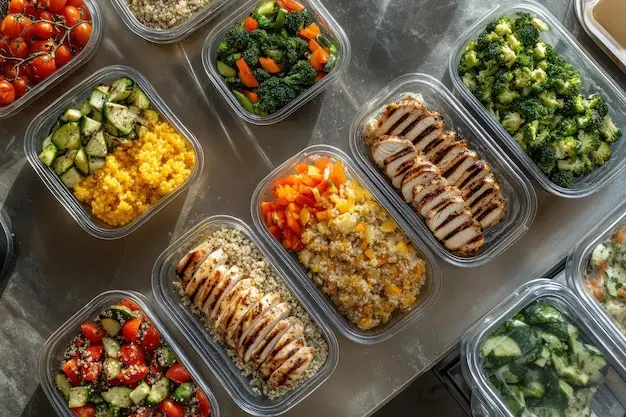Meal prepping has become a cornerstone for anyone looking to save time, eat healthier, and manage their budget effectively. By dedicating a few hours each week to prepare meals in advance, you can streamline your daily routine and ensure that you always have delicious, nutritious options on hand. In this comprehensive guide, we will walk you through everything you need to know to master the art of meal prepping like a pro.
What Is Meal Prepping and Why Is It Important?
Meal prepping involves planning, preparing, and portioning meals in advance. Whether you’re a busy professional, a fitness enthusiast, or someone simply looking to improve their eating habits, meal prepping offers benefits such as:
- Time Savings: Cook once and enjoy multiple meals throughout the week.
- Healthier Choices: Avoid impulse eating by having ready-to-go meals.
- Cost Efficiency: Reduce food waste and save money by buying in bulk.
Step 1: Set Clear Goals
Before you start meal prepping, identify your objectives. Are you aiming to lose weight, build muscle, or just eat more balanced meals? Understanding your goals will help you tailor your meal plans accordingly.
- Calorie Count: Determine your daily caloric needs.
- Dietary Preferences: Decide if you’ll follow specific diets like keto, vegan, or paleo.
- Meal Frequency: Choose how many meals and snacks you need per day.
Step 2: Plan Your Meals
Effective meal prep begins with a solid plan. This ensures you have variety and balance in your diet. Here’s how to create a meal prep plan:
- Choose Recipes: Select a mix of proteins, carbs, and vegetables.
- Make a Grocery List: List all ingredients to avoid multiple trips to the store.
- Portion Sizes: Use your goals to determine serving sizes for each meal.
- Incorporate Variety: Rotate recipes to prevent boredom and ensure nutritional balance.
Step 3: Invest in the Right Tools
Having the right equipment can significantly simplify the meal prep process. Consider investing in:
- Storage Containers: Opt for BPA-free, stackable, and microwave-safe options.
- Kitchen Gadgets: Use tools like a food processor, slow cooker, or instant pot for efficiency.
- Measuring Tools: Invest in a kitchen scale, measuring cups, and spoons to maintain accuracy.
Step 4: Grocery Shopping Tips
Smart shopping is key to successful meal prepping. Follow these tips for an efficient grocery trip:
- Shop with a List: Stick to your pre-planned list to avoid unnecessary purchases.
- Buy in Bulk: Purchase staples like rice, pasta, and canned goods in larger quantities.
- Seasonal Produce: Opt for fruits and vegetables in season for better quality and lower prices.
- Don’t Forget Snacks: Include healthy snack options like nuts, yogurt, or fruit.
Step 5: Prep Ingredients in Advance
Once you’ve completed your shopping, it’s time to prepare your ingredients. Here are steps to streamline the prep process:
- Wash and Chop Vegetables: Store them in airtight containers for easy access.
- Marinate Proteins: Add flavor to your chicken, fish, or tofu with marinades.
- Cook Staples in Batches: Prepare large quantities of rice, quinoa, or beans to use throughout the week.
Step 6: Assemble Your Meals
Now that your ingredients are ready, it’s time to assemble your meals. Follow these guidelines:
- Balance Macronutrients: Aim for a mix of protein, carbs, and healthy fats in each meal.
- Use Compartmentalized Containers: These help keep ingredients fresh and separate.
- Label and Date: Clearly mark each container with the meal type and preparation date.
Step 7: Proper Storage and Reheating
Storing your meals correctly ensures freshness and food safety. Use these tips:
- Refrigeration: Store meals you plan to eat within 3-4 days in the fridge.
- Freezing: Freeze meals you won’t eat immediately to extend shelf life.
- Reheat Safely: Use a microwave or stovetop to reheat meals evenly.
Tips for Long-Term Success
Consistency is key when it comes to meal prepping. Here are some tips to stay on track:
- Evaluate Weekly: Assess what worked and what didn’t to refine your process.
- Keep It Simple: Avoid overcomplicating recipes, especially when starting out.
- Involve Family or Friends: Meal prep together for added motivation and fun.
- Stay Inspired: Follow meal prep blogs, social media accounts, or cookbooks for fresh ideas.
Common Meal Prep Mistakes to Avoid
Avoid these pitfalls to make the most of your meal prep efforts:
- Overcooking Veggies: This can lead to mushy textures. Cook vegetables al dente.
- Lack of Variety: Rotate recipes to prevent meal fatigue.
- Skipping Snacks: Forgetting to prep snacks can lead to unhealthy choices later.
- Improper Storage: Use airtight containers to maintain freshness.
Sample Meal Prep Schedule
Here’s an example of a simple meal prep schedule:
- Sunday Morning: Plan meals and create a grocery list.
- Sunday Afternoon: Shop for groceries.
- Sunday Evening: Cook, assemble, and store meals for the week.
- Midweek: Refresh ingredients or prep additional meals if needed.
Conclusion
Mastering meal prepping takes practice, but the benefits are well worth the effort. By following this step-by-step guide, you can save time, eat healthier, and reduce stress during the week. Start small, stay consistent, and watch your efficiency and satisfaction with your meals improve dramatically.














What do you think?
Show comments / Leave a comment